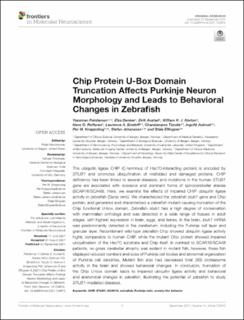| dc.contributor.author | Pakdaman, Yasaman | |
| dc.contributor.author | Denker, Elsa | |
| dc.contributor.author | Austad, Eirik | |
| dc.contributor.author | Norton, William H.J. | |
| dc.contributor.author | Rolfsnes, Hans Olav | |
| dc.contributor.author | Bindoff, Laurence Albert | |
| dc.contributor.author | Tzoulis, Charalampos | |
| dc.contributor.author | Aukrust, Ingvild | |
| dc.contributor.author | Knappskog, Per Morten | |
| dc.contributor.author | Johansson, Stefan | |
| dc.contributor.author | Ellingsen, Ståle | |
| dc.date.accessioned | 2021-11-26T13:30:10Z | |
| dc.date.available | 2021-11-26T13:30:10Z | |
| dc.date.created | 2021-11-18T13:21:00Z | |
| dc.date.issued | 2021-09-24 | |
| dc.identifier.issn | 1662-5099 | |
| dc.identifier.uri | https://hdl.handle.net/11250/2831709 | |
| dc.description.abstract | The ubiquitin ligase CHIP (C-terminus of Hsc70-interacting protein) is encoded by STUB1 and promotes ubiquitination of misfolded and damaged proteins. CHIP deficiency has been linked to several diseases, and mutations in the human STUB1 gene are associated with recessive and dominant forms of spinocerebellar ataxias (SCAR16/SCA48). Here, we examine the effects of impaired CHIP ubiquitin ligase activity in zebrafish (Danio rerio). We characterized the zebrafish stub1 gene and Chip protein, and generated and characterized a zebrafish mutant causing truncation of the Chip functional U-box domain. Zebrafish stub1 has a high degree of conservation with mammalian orthologs and was detected in a wide range of tissues in adult stages, with highest expression in brain, eggs, and testes. In the brain, stub1 mRNA was predominantly detected in the cerebellum, including the Purkinje cell layer and granular layer. Recombinant wild-type zebrafish Chip showed ubiquitin ligase activity highly comparable to human CHIP, while the mutant Chip protein showed impaired ubiquitination of the Hsc70 substrate and Chip itself. In contrast to SCAR16/SCA48 patients, no gross cerebellar atrophy was evident in mutant fish, however, these fish displayed reduced numbers and sizes of Purkinje cell bodies and abnormal organization of Purkinje cell dendrites. Mutant fish also had decreased total 26S proteasome activity in the brain and showed behavioral changes. In conclusion, truncation of the Chip U-box domain leads to impaired ubiquitin ligase activity and behavioral and anatomical changes in zebrafish, illustrating the potential of zebrafish to study STUB1-mediated diseases. | en_US |
| dc.language.iso | eng | en_US |
| dc.publisher | Frontiers | en_US |
| dc.rights | Navngivelse 4.0 Internasjonal | * |
| dc.rights.uri | http://creativecommons.org/licenses/by/4.0/deed.no | * |
| dc.title | Chip protein U-box domain truncation affects Purkinje neuron morphology and leads to behavioral changes in zebrafish | en_US |
| dc.type | Journal article | en_US |
| dc.type | Peer reviewed | en_US |
| dc.description.version | publishedVersion | en_US |
| dc.rights.holder | Copyright 2021 the authors | en_US |
| dc.source.articlenumber | 723912 | en_US |
| cristin.ispublished | true | |
| cristin.fulltext | original | |
| cristin.qualitycode | 1 | |
| dc.identifier.doi | 10.3389/fnmol.2021.723912 | |
| dc.identifier.cristin | 1955976 | |
| dc.source.journal | Frontiers in Molecular Neuroscience | en_US |
| dc.identifier.citation | Frontiers in Molecular Neuroscience. 2021, 14, 723912. | en_US |
| dc.source.volume | 14 | en_US |

